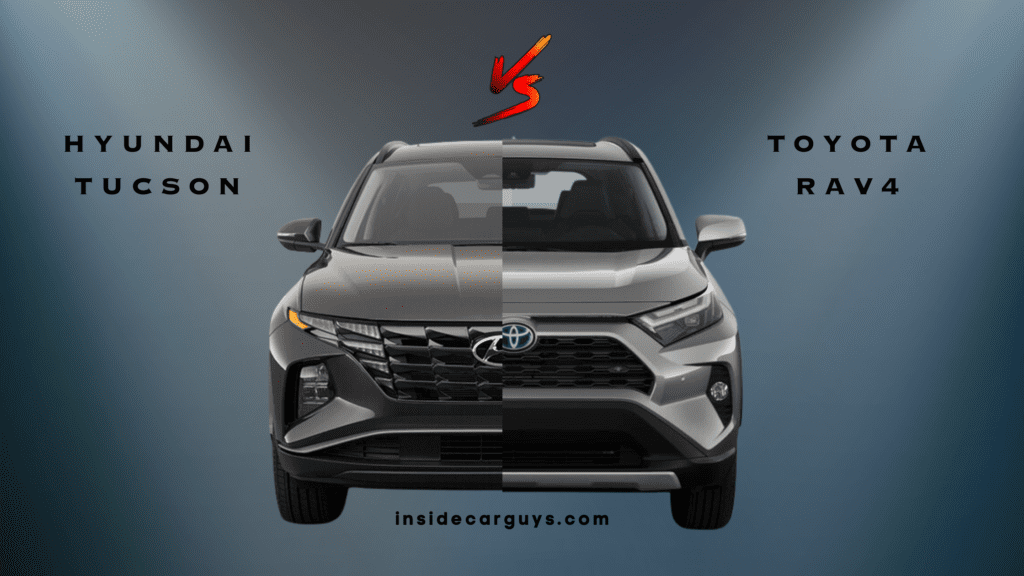Navigating the world of compact SUVs can be a daunting task, with numerous options vying for attention. Two standout choices in this increasingly popular segment are the 2023 Hyundai Tucson and Toyota RAV4.
Both vehicles offer a mix of style, performance, and practicality, but which one is the right fit for you? In this comprehensive comparison, we’ll explore the similarities and differences between these two SUVs to help you make an informed decision.
Exterior Design
The 2023 Hyundai Tucson sports a bold and futuristic design, thanks to its intricate grille, angular LED headlamps, and sharp body lines. The Tucson’s eye-catching design is a departure from traditional SUV styling, making it an appealing choice for those who appreciate a unique look.
The RAV4 takes a more rugged approach to exterior design, with a distinctive grille, angular LED headlights, and sculpted body lines. The overall appearance of the RAV4 exudes confidence and off-road capability, making it a popular choice among adventure enthusiasts.
Interior Design
The interior of the Tucson is both modern and comfortable, featuring high-quality materials and a sleek, minimalist dashboard design. The 10.25-inch infotainment touchscreen is seamlessly integrated into the dash, providing easy access to essential functions. The interior also offers ambient lighting options, allowing drivers to personalize the cabin atmosphere.
The RAV4’s interior combines practicality with a sense of style. It features soft-touch materials, an intuitive dashboard layout, and an 8-inch touchscreen infotainment system. The available SofTex-trimmed seats and panoramic moonroof add a touch of luxury to the RAV4’s interior.
Seating
The Tucson comfortably seats five passengers, with ample head and legroom in both the front and rear seats. The standard cloth upholstery is comfortable, while the available leather seating surfaces offer a premium touch. Optional heated and ventilated front seats, as well as heated rear seats, provide additional comfort during extreme temperatures.
The RAV4 also accommodates five passengers with ease. The seats are supportive and comfortable, providing ample space for both front and rear passengers. Optional features such as SofTex-trimmed seats, heated front seats, and a power-adjustable driver’s seat further enhance the cabin’s comfort.
Storage
The Tucson offers an impressive 38.7 cubic feet of cargo space behind the rear seats, which can be expanded to 74.8 cubic feet by folding the second-row seats. Additionally, the Tucson features an underfloor storage compartment and various cubbies throughout the cabin for added convenience.
The RAV4 boasts 37.6 cubic feet of cargo space behind the rear seats, which can be increased to 69.8 cubic feet when the second-row seats are folded down. The RAV4 also offers an array of storage compartments and cup holders for added practicality.
Performance
The Tucson comes with two engine options: a 2.5-liter four-cylinder engine producing 187 horsepower and a 1.6-liter turbocharged four-cylinder engine generating 226 horsepower in the hybrid and plug-in hybrid models. Both engines are paired with an eight-speed automatic transmission, providing smooth and responsive performance.
The RAV4 offers a 2.5-liter four-cylinder engine with 203 horsepower, as well as a hybrid option that pairs the same engine with an electric motor, delivering a combined 219 horsepower. The standard engine is mated to an eight-speed automatic transmission, while the hybrid uses a continuously variable transmission (CVT).
Fuel Efficiency
The base 2.5-liter engine in the Tucson offers an EPA-estimated fuel economy of 26 mpg city, 33 mpg highway, and 29 mpg combined. The hybrid and plug-in hybrid models deliver even better efficiency, with the hybrid achieving 38 mpg combined and the plug-in hybrid boasting an impressive 80 MPGe combined, as well as 32 miles of all-electric range.
The RAV4’s standard 2.5-liter engine offers an EPA-estimated fuel economy of 27 mpg city, 35 mpg highway, and 30 mpg combined. The hybrid variant achieves 41 mpg city, 38 mpg highway, and 40 mpg combined, making it a more fuel-efficient option for those seeking better gas mileage.
Safety
The Tucson is equipped with numerous safety features, including standard forward-collision warning with pedestrian detection, lane-keeping assist, and automatic high beams. Additional available safety features include adaptive cruise control, blind-spot monitoring, rear cross-traffic alert, and a surround-view parking camera system.
The RAV4 also offers an impressive suite of safety features as part of the standard Toyota Safety Sense 2.0 system, which includes pre-collision warning with pedestrian detection, adaptive cruise control, lane departure warning with steering assist, and automatic high beams. Optional safety features include blind-spot monitoring, rear cross-traffic alert, and front and rear parking sensors.
Trim Levels
The Tucson is available in four trim levels: SE, SEL, N Line, and Limited. Each trim offers a different set of features and options, with the base SE coming well-equipped with an 8-inch touchscreen, Apple CarPlay and Android Auto integration, and a suite of safety features. Higher trims add features such as larger touchscreens, wireless charging, and a panoramic sunroof.
The RAV4 comes in six trim levels: LE, XLE, XLE Premium, Adventure, TRD Off-Road, and Limited. The base LE trim includes features such as a 7-inch touchscreen, Apple CarPlay and Android Auto compatibility, and Toyota Safety Sense 2.0. Higher trims add features like a power liftgate, SofTex-trimmed seats, and an upgraded JBL audio system.
Pricing
The Tucson has a starting price of around $25,000 for the base SE trim, with the range-topping Limited trim starting at around $35,000. Hybrid and plug-in hybrid models come at a premium, with prices ranging from approximately $30,000 to $40,000, depending on the trim and options selected.
The RAV4’s base LE trim starts at around $26,000, with the top-of-the-line Limited trim starting at around $35,000. Hybrid models start at approximately $29,000, while the plug-in hybrid RAV4 Prime starts at around $39,000.
Both the Hyundai Tucson and Toyota RAV4 offer an attractive combination of style, performance, and features in the compact SUV segment. The Tucson stands out for its bold design, spacious interior, and efficient hybrid options, while the RAV4 offers rugged styling, a comfortable cabin, and a proven reputation for reliability. Ultimately, the choice between these two vehicles comes down to personal preference and priorities.
Key Differences
The 2023 Hyundai Tucson and Toyota RAV4 are both exceptional compact SUVs with a lot to offer, but there are several key differences to consider when deciding which one is right for you.
Design
The exterior design of the Tucson is bold and futuristic, featuring intricate grille details and angular LED headlamps. In contrast, the RAV4 has a more rugged appearance, with a distinctive grille, sculpted body lines, and off-road inspired styling elements.
The choice between the two designs ultimately comes down to personal preference, with the Tucson appealing to those who value a more modern aesthetic, while the RAV4 caters to adventure enthusiasts who prefer a rugged look.
Interior Space and Comfort
Both vehicles offer spacious and comfortable interiors, but the Tucson slightly edges out the RAV4 in terms of cargo capacity. The Tucson provides 38.7 cubic feet of space behind the rear seats and 74.8 cubic feet with the seats folded down, while the RAV4 offers 37.6 cubic feet and 69.8 cubic feet, respectively.
Performance and Fuel Efficiency
The RAV4 comes with a slightly more powerful base engine (203 horsepower) compared to the Tucson’s base engine (187 horsepower). However, the Tucson’s hybrid options produce more power, with the 1.6-liter turbocharged engine generating 226 horsepower, while the RAV4’s hybrid option delivers a combined 219 horsepower.
In terms of fuel efficiency, the Tucson’s hybrid and plug-in hybrid models offer better fuel economy than the RAV4’s hybrid variant, with the Tucson hybrid achieving 38 mpg combined and the plug-in hybrid boasting an impressive 80 MPGe combined. The RAV4 hybrid, on the other hand, achieves a combined fuel economy of 40 mpg.
Safety Features
Both SUVs come equipped with an array of standard safety features, such as forward-collision warning with pedestrian detection and lane-keeping assist. While the specific safety technologies may vary slightly between the two vehicles, both manufacturers prioritize safety and provide comprehensive safety suites.
Trim Levels and Pricing
The RAV4 offers more trim levels (six) compared to the Tucson (four), which may provide greater flexibility for buyers seeking specific features or configurations. In terms of pricing, both vehicles have a similar starting price, but the RAV4’s base price is slightly higher than the Tucson’s. Additionally, the Tucson’s hybrid and plug-in hybrid models tend to be more affordable than the RAV4’s hybrid and plug-in hybrid options.
In conclusion, the key differences between the 2023 Hyundai Tucson and Toyota RAV4 come down to design, interior space, performance, fuel efficiency, trim levels, and pricing. These factors should be carefully considered when deciding which compact SUV best suits your needs and preferences.
Final Thoughts
After delving into the various aspects of the 2023 Hyundai Tucson and Toyota RAV4, it’s clear that both vehicles have a lot to offer in the compact SUV market. With their unique design approaches, performance capabilities, and feature offerings, each SUV caters to a specific audience.
The Tucson’s bold design, efficient hybrid options, and spacious interior make it a compelling choice, while the RAV4’s rugged styling, proven reliability, and versatile trim options hold great appeal for many buyers. Ultimately, your decision will come down to personal preference, priorities, and the specific features that resonate with you the most.
Features Breakdown
Hyundai Tucson
- Exterior Design:
- Bold and futuristic design
- Intricate grille and angular LED headlamps
- Sharp body lines
- Interior Design:
- Modern and comfortable
- High-quality materials
- Sleek, minimalist dashboard
- 10.25-inch infotainment touchscreen
- Seating:
- Comfortable seating for five passengers
- Ample head and legroom
- Optional leather seating surfaces
- Heated and ventilated front seats (optional)
- Heated rear seats (optional)
- Storage:
- 38.7 cubic feet of cargo space (seats up)
- 74.8 cubic feet of cargo space (seats folded)
- Underfloor storage compartment
- Performance:
- 2.5-liter four-cylinder engine (187 horsepower)
- 1.6-liter turbocharged four-cylinder engine (226 horsepower) for hybrid and plug-in hybrid models
- Eight-speed automatic transmission
- Fuel Efficiency:
- 26 mpg city, 33 mpg highway, and 29 mpg combined (base engine)
- 38 mpg combined (hybrid)
- 80 MPGe combined (plug-in hybrid)
- Safety:
- Standard forward-collision warning with pedestrian detection
- Lane-keeping assist
- Automatic high beams
- Optional adaptive cruise control, blind-spot monitoring, and rear cross-traffic alert
- Trim Levels:
- SE, SEL, N Line, Limited
- Pricing:
- Starts at around $25,000 for the base SE trim
- Ranges up to around $40,000 for the plug-in hybrid model
Toyota RAV4
- Exterior Design:
- Rugged and off-road inspired design
- Distinctive grille and angular LED headlights
- Sculpted body lines
- Interior Design:
- Practical and stylish
- Soft-touch materials
- Intuitive dashboard layout
- 8-inch touchscreen infotainment system
- Seating:
- Comfortable seating for five passengers
- Supportive and spacious seats
- Optional SofTex-trimmed seats and heated front seats
- Storage:
- 37.6 cubic feet of cargo space (seats up)
- 69.8 cubic feet of cargo space (seats folded)
- Performance:
- 2.5-liter four-cylinder engine (203 horsepower)
- Hybrid option with a combined 219 horsepower
- Eight-speed automatic transmission (standard)
- Continuously variable transmission (hybrid)
- Fuel Efficiency:
- 27 mpg city, 35 mpg highway, and 30 mpg combined (base engine)
- 41 mpg city, 38 mpg highway, and 40 mpg combined (hybrid)
- Safety:
- Toyota Safety Sense 2.0 system
- Pre-collision warning with pedestrian detection
- Adaptive cruise control
- Lane departure warning with steering assist
- Optional blind-spot monitoring and rear cross-traffic alert
- Trim Levels:
- LE, XLE, XLE Premium, Adventure, TRD Off-Road, Limited
- Pricing:
- Starts at around $26,000 for the base LE trim
- Ranges up to around $39,000 for the plug-in hybrid RAV4 Prime





